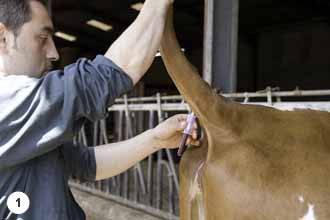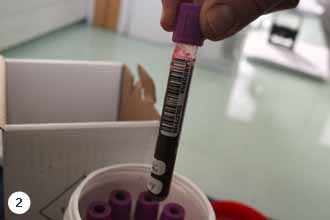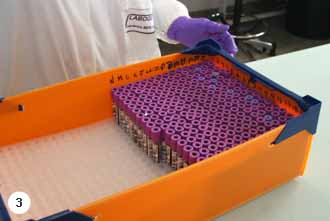
French genetics
for cattle, sheep
and goat industries
-
Languages :







- Subscribe to the newsletter RSS
-
- Home >
- Breeding programs and technologies >
- Integrating emerging technologies >
- The genomic selection
Integrating emerging technologies
The genomic selection

A technology-driven revolution
In addition to data used in conventional evaluations (pedigree and performances), genomic selection exploits the added value of information garnered through DNA analysis via new DNA mapping-based genotyping technologies.
Genomic selection does not involve any genetic modification: neither the animals evaluated nor their genetic potential become modified. Genomics ‘simply’ offers a powerful new tool for assessing the genetic quality of livestock.
These breakthroughs have now made it possible to evaluate a breeder sire even before it has reached maturity, without having to wait for its progeny to start producing. The net result is that genomic selection enables to increase greatly annual genetic gain. Furthermore, indexing on functional traits (such as fertility, mastitis resistance, calving ease) is now much sharper than before.
Genomic selection has been the biggest technology-driven breakthrough to happen in genetic improvement over the last 40 years.
Size the decisive factor for breed reference populations
The pivotal first step in the genomic evaluation of sires in a given breed is to build up a reference population ― a purebred set of fully genotyped and progeny-tested breed animals.
This population serves as a basis for analyzing genotype-performance relationships. Mathematical modelling has established statistical relationships between genotype profiles and the indexes calculated after progeny testing.
The robustness of these formulae for predicting genetic values from genotypes hinges on the number of animals making up the reference population. The larger the reference population, the sharper the statistical correlations.
Once these predictive formulae have been established and verified, they can be employed to estimate a series of genetic indexes for a young animal using its genotype data.
This means that the genomic evaluation can only focus on the progeny-tested traits. The reference population still has to be renewed every year by progeny testing new animals in order to continually optimize the predictive formulae.
The genomic evaluation can therefore only be efficient if it gets a regular input of dense (size of the reference population) fresh (population re-updating) information.
From source animal to a genomic index set : the phases
Sampling


99% of tissue samples are on plasma (1). Each sample is barcoded to ensure full end-to-end process traceability (2).
Each test tube holds 6 ml of blood plasma instead of the 4 ml used for conventional analyses, so that the control genetic material can be preserved long-term.
DNA extraction


LABOGENA, the French national animal genetics analysis lab, takes 5 days to complete the full battery of sample analysis protocols (3).
The analytical chain is computer-controlled and automated end-to-end. Phase 1 is DNA extraction (4), and the process requires fifteen times more material than conventional analyses.
DNA preparation


The extracted DNA is recovered then distributed by a TECAN liquid handling robot into 96-well microplates, i.e. DNA from 96 different animals (5).
The robot dispenser system then adds the reagents necessary for DNA denaturation (6). Each microwell plate is then placed in a lab stirrer to mix the reagents with the DNA.
Reading of genetic markers


After centrifugation (7), a final incubation step (24 hours at 37°C), and DNA fragmentation, the samples are dispensed onto a microarray (8).
Adding fluorescent reagents then makes it possible to scan and read the genetic markers of each DNA sample.
Analysis and indexing


The results are forwarded on to the INRA via the French national genetics information system (9). Genetic indexing is coordinated under INRA leadership, with support from UNCEIA and Institut de l’Elevage geneticists.
The selection business that supplied the samples then uses these results to select which bulls to continue siring (10).
Key figures
- 15 years of scientific genomics research
- 10 years of genomic application in selection programmes
- 750 000 animals already genotyped for selection purposes
- 3 breeds benefitting from genomic evaluations
- 15 breeds soon able to benefit from genomic evaluations
- 1 major gene selected for at large-scale in the sheep species
- 2 large-scale programmes targeting product quality



































